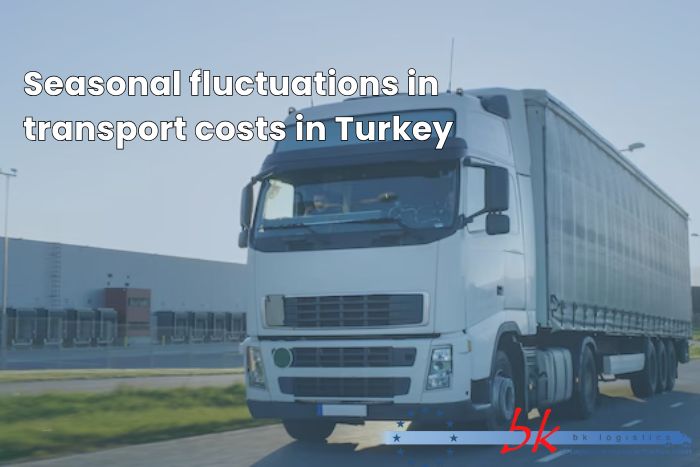News
Seasonal Fluctuations in Transportation Costs in Turkey
Contents
-
The impact of seasonal fluctuations on transportation
-
The role of seasons in the transportation sector in Turkey
-
Reasons for the increase in transportation costs in winter
-
Summer transportation processes and cost advantages
-
The importance of logistics planning in spring and autumn
-
Seasonal demand changes
-
The impact of fuel prices and weather conditions
-
Consideration of seasonal traffic and road conditions on costs
-
The impact of seasonal storage needs on transportation costs
-
Seasonal risk management and logistics strategies
-
Technological solutions for adapting to seasonal fluctuations
-
Precautions transportation companies can take against seasonal fluctuations
-
Trends and innovations to reduce seasonal fluctuations in the future
The impact of seasonal fluctuations on transportation
Transportation costs are subject to significant fluctuations depending on the season. Seasonal conditions in Turkey affect the planning of logistics processes and cost calculations. Factors such as weather, demand intensity, and road conditions cause seasonal fluctuations in the transportation sector.
If companies do not develop strategies to address these changes, both costs and delivery times increase. Preparation for seasonal fluctuations is the key to improving logistics efficiency and cost control.
The role of seasons in the transportation sector in Turkey
The four seasons in Turkey affect transportation processes differently. While challenging road conditions such as snow and ice occur in winter months, temperature and tourism mobility impact logistics operations in summer months. In spring and autumn, weather conditions are relatively milder, but sudden weather changes can occur.
Each season brings its own challenges and advantages. These conditions affect not only transportation costs but also transportation duration and risks. Understanding the impact of seasons on transportation is essential for planning and cost management.
Reasons for the increase in transportation costs in winter
In the winter months, transportation costs increase most significantly. Snowfall, frost, and ice reduce traffic safety and extend transportation times. Drivers must be particularly cautious and drive slowly. Additionally, vehicle maintenance and repair needs increase under winter conditions.
In cold weather, fuel consumption may increase. Transportation companies must take special equipment and precautions to adapt to winter conditions. These factors are among the main reasons for the increase in overall transportation costs.

Summer transportation processes and cost advantages
In the summer months, weather conditions are generally more favorable, and roads are more open. This shortens transportation times, allowing processes to be completed more quickly. Additionally, fuel consumption is more stable. Therefore, costs may be lower in summer.
However, tourism and holiday periods in summer can lead to increased traffic in some regions. This may cause delays and higher transportation costs on certain routes. With proper planning, these impacts can be minimized.
The importance of logistics planning in spring and autumn
Spring and autumn in Turkey generally have mild weather conditions. Transportation processes are relatively stable during these seasons. However, sudden rainfall or weather changes can complicate logistics planning.
Flexible route planning and the establishment of alternative routes are important during these periods. Preparing storage facilities and transportation vehicles prevents potential disruptions. Spring and autumn offer opportunities to keep transportation costs under control.
Seasonal demand changes
Seasonal fluctuations in transportation demand are also observed. In particular, agricultural products and seasonal goods are transported heavily during certain times of the year. This increased demand can strain transportation capacity and lead to higher transportation costs.
The seasonal increase or decrease in trade volume requires transportation companies to use their resources effectively. During high-demand periods, the need for vehicles and personnel increases, while capacity utilization decreases in the off-season. Therefore, demand forecasting and planning are of great importance.
The impact of fuel prices and weather conditions
Seasonal weather conditions directly affect fuel consumption. In cold weather, engines often consume more fuel. Factors such as wind and precipitation also reduce fuel efficiency.
Fuel prices in Turkey can fluctuate seasonally. Demand increases, as well as economic and political developments, affect fuel costs. The combination of these two factors plays a significant role in the fluctuation of transportation costs.
Consideration of seasonal traffic and road conditions on costs
Heavy traffic and poor road conditions slow down the transportation process and increase transportation costs. Traffic density varies by season in different regions. Especially in the summer months, the start of the tourism season causes main roads to become congested.
In winter months, ice and snowfall can lead to road closures. This requires the use of alternative routes, increasing costs due to longer distances. Seasonal impacts on road infrastructure should be considered in the planning of logistics processes.
The impact of seasonal storage needs on transportation costs
In certain seasons, particularly in winter and spring, storage needs increase. Due to cold weather, some products must be stored for longer periods. Storage costs constitute a significant portion of total transportation costs.
The use of storage facilities should be optimized based on seasonal demand changes. Proper storage selection is critical for product safety and transportation planning. This reduces costs and keeps transportation times under control.
Seasonal risk management and logistics strategies
Seasonal fluctuations require risk management in logistics. Potential risks should be identified during the planning phase, and appropriate measures should be developed. Alternative route options and flexible transportation plans minimize risks.
Insurance practices and contingency plans reduce potential losses. Transportation companies should be prepared for seasonal risks through employee training and technological support. These approaches prevent unexpected cost increases.
Technological solutions for adapting to seasonal fluctuations
Technology plays a significant role in reducing the impact of seasonal changes. GPS tracking systems, real-time weather information, and route optimization software make logistics processes more flexible, preventing delays and cost increases.
Cargo tracking and management through digital platforms provide transparency. Automated planning tools enable quick responses to seasonal demands. This allows for more effective control of transportation costs.
Precautions transportation companies can take against seasonal fluctuations
Transportation companies employ various strategies to adapt to seasonal changes. Measures such as regular vehicle maintenance, driver training, and the use of winter tires reduce risks in the winter months. In the summer months, route planning is conducted considering traffic density.
Flexible working hours and planning of reserve personnel address sudden demand changes. Increasing storage capacity and using alternative transportation routes provide cost advantages. Companies invest in continuous and up-to-date data analysis to be prepared for seasonal fluctuations.
Trends and innovations to reduce seasonal fluctuations in the future
Sustainable and environmentally friendly solutions in logistics aim to reduce the impact of seasonal fluctuations. The use of electric and hybrid vehicles is increasing. Smart city projects and infrastructure improvements minimize traffic problems.
Artificial intelligence and machine learning enable more accurate demand forecasts. These developments make transportation costs more predictable. The rapid adoption of these innovations in Turkey enhances the competitiveness of logistics.



